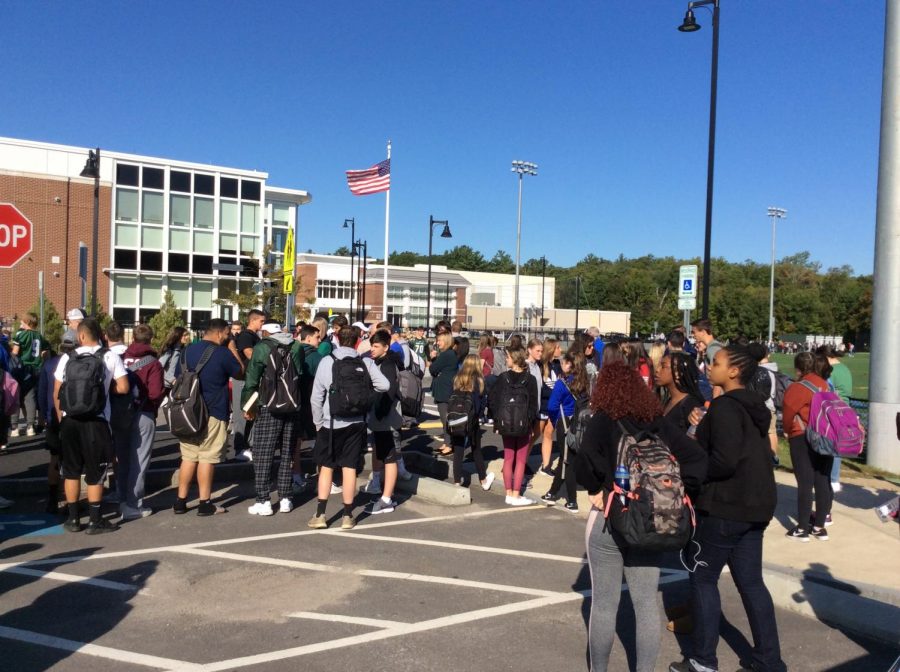Desensitized to Violence and Emergency Situations
Students Must Respond to Alarms More Seriously
Ms. Pflaumer, newspaper advisor
On Thursday, September 19, 2019, high school students along with middle school and Pre-K participated in an ALICE training. Unlike the surprise false alarm on the first day of school, this one was scheduled and announced in advance.
Abington Middle-High School has adopted a threat response system of ALICE, which stands for Alert, Lockdown, Inform, Counter, and Evacuate. These steps are suggestions for reacting to emergency situations and can be carried out in any order.
On August 29, around 7:10 AM, an “emergency situation” announcement was broadcast over the intercom throughout the Abington Middle High School. The school was evacuated. It turned out to be a false alarm.
False alarms of one type or another have been called three times so far in two academic school years. One of these was called during homeroom on August 29, 2018. An unplanned fire alarm was called on December 11, 2018, alerting police and fire. Another fire alarm was called during homeroom on October 19, 2018.
During the August 29 false alarm, the building was quickly and efficiently evacuated. Students cleared the building and got across the street quickly. But this was the extent of the success of the students’ response.
After evacuating the building, students were in a big, easily targeted, group. Students did not spread out away from the building but stood just past the sidewalk in the same way they do for a fire drill. The reaction of the student body was too lax, because at that point the students did not know that it was a false alarm. If alarms sound for any reason and are not announced as a planned drill, it is important that students treat them as real.
Mass violence is all too common in the news today. It seems like every week a new mass shooting is in the headlines. It is common to hear of a high school being threatened by a shooter, or other type of emergency. This is in part why threat preparedness is discussed in the classroom and police patrol our schools. This is why our staff trains regularly on school safety and responding to threats of many kinds. This is why our administration has adopted ALICE to teach students and staff when and how to respond to threats of any kind and why our teachers have emergency supplies in their classroom. Students must respond to these alarms with fear and shock because violence is something that does happen in schools.
Although no credible threat was found in the school and students were let back into the building, students did not fully respond as the ALICE training recommends. According to the constant contact email sent out later that morning by superintendent Schafer, the false alarm was caused by “an electrical failure as the students were entering the building.” Gathering outside in a big group goes against our ALICE training which suggests that we hide or go to a separate meeting point.
Any number of things could have been inside of the school building on that day. The assumption that nothing was wrong is a problem. Students cannot become desensitized to the threat level that these alarms indicate. Students need to respond to the situation as an unknown threat, not as a false alarm. Students need to respond to it as an emergency, not as a nuisance.
Let’s not assume that alarms are always false alarms and instead react as if the threats are always real, even if that is unlikely to be true.


Alex Jernegan • Dec 5, 2019 at 11:52 AM
i agree i was scared out of my mind when this happened
Grace O’Donnell • Oct 2, 2019 at 8:23 AM
Thank you for writing this article. The fear of walking into school and not walking out one day has become real and it seems society has indeed become desensitized to these frequent happenings of violent threats being aimed at schools public, or not. It seems it takes many voices, screaming at the top of their lungs, numerous times, for these concerns to finally be noticed. While the staff in not just the district of abington but all across the world have had the best intentions in implementing these emergency evacuation plans, the examples being set consist of telling students when and how the drill will occur, which allows students to become comfortable with each drill and treat every one as if it is a false alarm. Even after the fact, it seems that our concerns are almost shut down. While we are allowed to discuss it, I personally have felt like I haven’t gotten a decent amount of time to speak for not just my own concerns but the student body’s as a whole, as well. The few times that there have been “False alarms” during the last two academic school years, Nobody was aware of any possible threat and we sat in corners like sitting ducks, some students using electronics, and others just waiting, scared that this was real. I’m glad that finally these situations are being discussed but much more needs to be done in order to fully be prepared for any situation god forbid should we ever encounter one.
kerrin • Oct 1, 2019 at 6:43 PM
incredible. inspiring. wonderful. practical. love it.
Maria Wood • Oct 1, 2019 at 6:16 PM
This is great, and reflects my thoughts on the situation exactly! I think we as students are so used to the system having flaws. I can relate, especially since I was stuck in a false alarm with my friend after school as an eighth grader. Scary, but true.